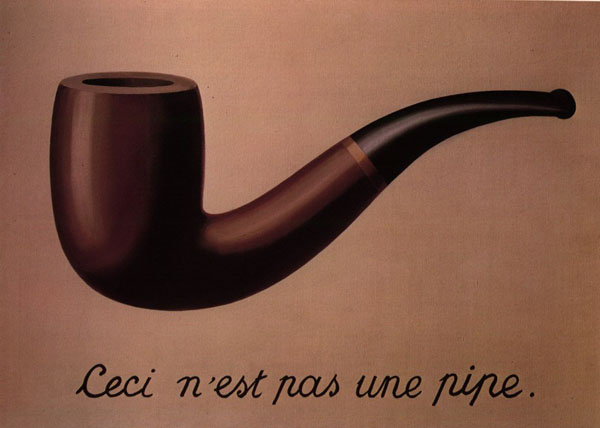Michell Foucault, This is Not a Pipe (1968)
Foucault, This is not a pipe

René Magritte, La Trahison des Images
-
To employ a calligram where are found, simultaneously present and visible, image, text, resemblance, affirmation and their common ground.
-
Then suddenly to open up, so that the calligram immediately decomposes and disappears, leaving as a trace only its own absence.
-
To allow discourse to collapse of its own weight and to acquire the visible shape of letters. Letters which, insofar as they are drawn, enter into an uncertain, indefinite relation, confused with the drawing itself--but minus any area to serve as a common ground.
-
To allow similitudes, on the other to multiply of themselves, to be born from their own vapour and to rise endlessly into an ether where they refer to nothing more than themselves.
-
To verify clearly, at the end of the operation, that the precipitate has changed colour, that it has gone from black to white, that the “This is a pipe” silently hidden in the mimetic representation has become the “This is not a pipe” of circulating similitudes.
A day will come when, by means of similitude
relayed indefinitely along the length of a series, the image itself, along
with the name it bears, will lose its identity. Campbell, Campbell, Campbell.(1)
(1) Foucault’s reference is not to Magritte but to Andy Warhol, whose various series of soup cans, celebrity portraits and so on Foucault apparently sees as undermining any sense of the unique, indivisible identity of their “models.” See Foucault’s comments on Warhol in the important essay “Theatricum Philosophicum” reprinted in Language, Counter Memory, Practice (Ithaca, New York: Cornell University Press, 1977).
From:
- "Ceci n'est pas une pipe," In Les Cahiers du chemin, n° 2 (15 janvier) 1968, 79-195.
- This is not a pipe (with illustrations and letters by Rene Magritte) Trans. and edited by James Harkness. Enlarged ed. Berkeley : University of California Press, 1983. [nb: this version has significant variations from the version in Dit et Ecrits.]
- "This is not a pipe," Aesthetics, Method and Epistemology, Ed. J. Faubion. Trans. James Harkness, modified. New York: New Press, 1998, 187-203.